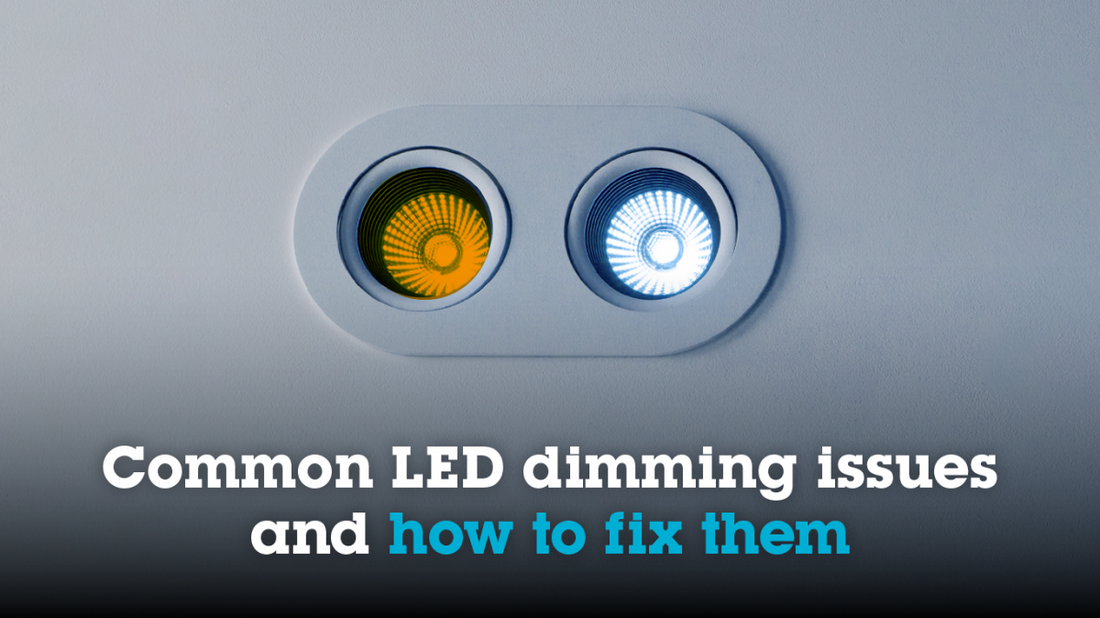LED dimming – doesn't sound that complicated, right?
Well, it shouldn’t be. But you’d probably be surprised with the amount of tech issues that arise when pairing LED with a dimmer. Especially if you opt for a dimmer that is not designed for LED. We have covered how to distinguish a dimmer designed for LED from a dimmer that’s not in a previous blog, but if there is one key thing to watch out for it’s the Triac model, a dimmer that is designed for dimming tungsten and halogen lamps: not LED.
But what are some of the most frequent issues encountered by contractors when dimming LED? Let us dive in...
Flicker and buzz
Flicker and buzz on your LED dimming installs are frustrating, both for the installer and the end-user. These unsavoury by-products of LED dimming can be a result of a few things. But the main two culprits behind flicker and buzz on an install in our eyes indicate either one of two things. You’ve used the wrong dimmer or Inrush current wreaking havoc on your install.
Fear not, both can be solved. But the solution can be frustrating if you’re stuck on-site with a product that is simply not doing the job you set out for it to do: dim LED flicker-free and silently.
Pairing LED with an incompatible dimmer
If you’ve paired LED with an incompatible dimmer, such as the Triac model then flicker and buzz is likely to be present. Inside a Triac dimmer is a copper coil, that works with resistive loads to disrupt the current reaching the lamp and it works for tungsten lamps. But why doesn’t it work with LED? LEDs operate on a continuous forward current: disrupt that current with a copper coil and you will see the disturbance in the light output (aka. Flicker).
It’s also the root cause of buzz. The copper coil inside a Triac dimmer is designed to absorb voltage spikes caused by the Triac switching on and off at the peak of the mains cycle and when the copper coil vibrates as it struggles with the LED load, it causes a painful buzzing noise.
Alongside flicker and buzz being by-products of a Triac dimmer, whilst on the surface it is entirely possible to dim LED with Triac, it just isn’t worth it in the long run. If you pair LED with Triac dimmers, you will find that the dimming range is very much limited, you will be shortening the lifespan of the LEDs, and might also be interfering with your clients Wi-Fi.
We’d suggest heading back to your local wholesaler and purchasing a dimmer designed to dim LED. Make sure you calculate your install correctly to guarantee the right pairing with the load you are trying to dim. More on that below as we lead nicely on to issue number 3.
Inrush current
Ok, so you’ve used the right dimmer – a dimmer designed to dim LED like the Zano Controls range. Why then is flicker and/or buzz still present? The answer unfortunately is Inrush current.
The wattage listed on an LED’s box is rarely the actual wattage used by the lamp. This is because of Inrush current – that spike in current that’s drawn by the LED power supply. It can make a significant difference to your installation’s total wattage. So, in this instance, flicker and buzz is not necessarily down to the tech inside the dimmer, but the wattage it is compatible with.
But what’s the solution in this case? As long as you’ve opted for good quality lamps from a trusted manufacturer then it would make sense to take the installation back to the beginning. Start by calculating the total load – 12 LED lamps at 8W each might sound safe enough for a 150W/VA LED dimmer if you were to simply multiply 12 by 8 (96 for all those mathematicians out there) but to safely account for Inrush current you need to multiply that number by 1.8 - this will give you the installations true total load. Which in our example above gives us a total load of 172W/VA. In this case, you would need to either swap out the lamps with a brand that keeps Inrush current to a minimum or upgrade your dimmer to a dimmer that can cope with a total load of above 172W/VA, such as our 5-250W/VA version.
To avoid Inrush wreaking havoc on future installs – make sure you calculate the total load prior to purchasing your dimmer. Once you’ve totalled up the actual wattage of the lamps, our easy product finder will take you to the product your need in a few simple steps.
LED dropout
Dropout is another frequent issue encountered by installers. It’s the sudden drop-off of light when dimming LED that occurs before you’ve been able to turn the controller all the way down, ruining an otherwise perfect install.
But why does that happen, and what’s the solution? It’s because you’re trying to dim low loads.
LEDs operate at a much lower wattage than traditional incandescent lamps. A single average warm white LED may be around 5W/VA, which is fine for your average 10-300W/VA dimmer, if you have a few of those lamps on a circuit. But if you were to try to install dimming controls on a circuit with a combined wattage of less than that. Say for example within a small closet with 2 or 3 3W/VA LED lamps on a circuit, you are likely to start encountering problems with dropout.
If you want to dim wattages below 10W/VA, you need a controller that dims down to 0W/VA so that the lamp can dim without risk of dropout (as well as flicker and buzz).
Poor quality LED lamps
Last but not least, the choice of LED lamp has a big impact on the performance of a dimmer and the quality of an installation. LEDs don’t produce light using heat, this is part that makes them so energy efficient. However, the downside is that their components are extremely sensitive to overheating, which can cause them to fail prematurely. When you purchase LEDs from trusted manufacturers they would have already been put through a series of rigorous tests. So it’s safe to assume that the solder wires and other components in the lamp are of a high enough quality, will last a long time and are efficiently designed to allow heat to escape.
Whether the client has chosen to keep costs down and purchase their own lamps (of which you had no say over the quality) or unbeknownst to you the lamps you’ve opted for don’t perform very well with a dimmer. Poor quality LED lamps that overheat easily, mean product failure can start quite quickly. Pair cheap lamps with a dimmer and it exasperates the problem.
If you need any further advice about which dimmers to use, or how to avoid LED performance issues, give us a call on 0345 519 5858.

